Canon XSi: 12.2 Megapixels, Image Stabilized Lens, and Double Live View
by Wesley Fink on May 5, 2008 3:00 AM EST- Posted in
- Digital Camera
XSi Features (cont'd)
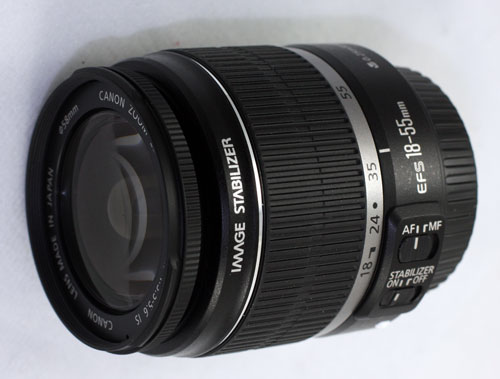
The first Canon 18-55mm lens was introduced with the 6MP Digital Rebel. At the time that lens was heralded as superb quality for a kit lens. The Digital Rebel is now in its fourth generation and resolution is doubled to 12.2MP. What was a great 6MP lens had become a not so wonderful 10MP lens on the XTi and it was time for an update with the move to 12MP.
Canon obliged with several minor changes to the 18-55mm layout and the addition of an aspherical element for one of the lenses. Canon has also developed a new simpler and lower-cost Image Stabilization system that is incorporated in the revised lens. While Optical Image Stabilization is built into lenses and only works with that IS lens it does offer the advantage of showing in the viewfinder, or on the Live View Screen, the true impact of the IS operation.
Mechanical Image Stabilization used by Sony, Pentax, and Olympus works with every lens you mount but you cannot see the effect through the viewfinder. However, recent implementations of Live View by these manufacturers allow the user in some cases to see the true effect of IS on Live View. Those are discussions for another article, but for now Canon, Nikon, and Panasonic have embraced Optical Image Stabilization.
Early testing shows the new 18-55mm IS to be a superb lens with performance comparable to top-line Canon lenses. Including an IS kit lens comes just in time as Sony, Pentax, and Olympus have all adopted mechanical IS built into the body in their entry cameras. Nikon is also offering an optical IS kit lens in their new D60.
Canon claims up to 4 stops of improved hand-holding with the new IS kit lens. We did find we could improve 2 to 3 stops in most situations, but the 4-stop advantage likely requires ideal conditions.
The most remarkable feature of the new IS lens, apart from quality images, is the price. Canon is including the 18-55mm IS for a premium of just $100 over the price of the body. Considering the real advantages of an optical IS lens it is definitely worth choosing the kit with the IS lens as it is $100 that is very well spent for the value received.
PC Remote Control
The prosumer 40D EOS utility software allows the user to remotely control the camera with your computer over a USB connection. This includes the option to record images directly to your hard disk. It was frankly a shock to see this same very Pro-oriented feature available now for the XSi. The utility now works on both the 40D and XSi and allows you to preprogram your PC or Mac for long exposures or for time-lapse photography. You can even focus and preview shots on the monitor in Live View mode.
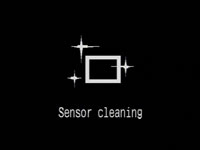
The EOS Integrated Cleaning System, first introduced on the Canon XTi, has been a feature of every Canon camera introduced since then. The system, which vibrates the sensor to shake off dust, is continued unchanged in the XSi.

Auto Lighting Optimization is a new option on the XSi. This feature was introduced on the 40D. Canon claims the Auto Lighting Optimizer improves dynamic range and it is on by default. Therefore you can see the impact of ALO in our test images.
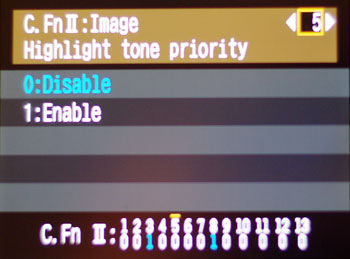
Those who prefer can turn off ALO in Custom Function 6. A related Custom Function 5 allows the user to enable/disable Highlight Tone Priority. This expands dynamic range from 18% grey to bright highlights. The downside is noise may increase in shadow areas. Both these dynamic range expansion features are brought over from the 40D. They work in PASM or A-DEP modes for JPEGs, but have no effect on images captured in RAW format.
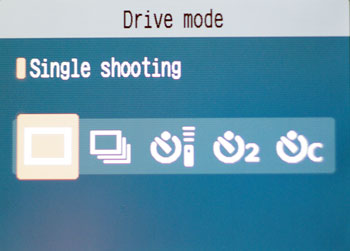
Continuous shooting is up to 3.5FPS, a slight increase from the 3FPS of the XTi despite the 20% increase in sensor resolution and image size. This makes the XSi one of the fastest entry DSLRs available in continuous mode. From the 40D the XSi also adds a 2 second timer mode (with optional mirror lockup) which is convenient for tripod shooting. The self-timer C option in the LCD screen shot above counts down from 10 seconds, but then takes a user selectable one to ten shots in succession to keep you from having to go back to the camera for second or third attempts.

The Rebel XSi is packaged in a big red splashy box for the US market. In Europe, where it is called the 450D, the packaging is a much more subtle Canon grey and black.
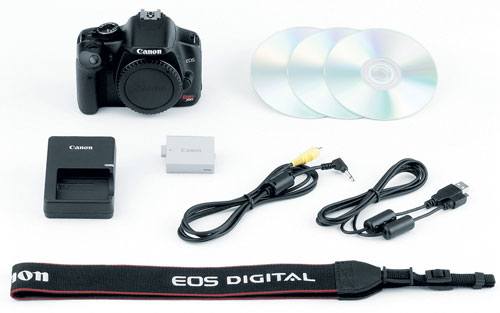
In the box you will find the rechargeable battery, charger, USB cable, video cable, Canon neck strap, software CDs, manuals, and warranty card(s). The most common kit with a lens includes the new 18-55mm f/3.5-5.6 IS (optical Image Stabilized) lens.










56 Comments
View All Comments
meanjean - Wednesday, September 3, 2008 - link
Anyone had trouble with memory cards not recording pictures because of being dislodged from contact points for some reason?thepieces - Saturday, May 10, 2008 - link
Cool review, but the samples are horrible. A little more effort than images from your back yard please :) Half of which are out of focusMidwayman - Friday, May 9, 2008 - link
"Early testing shows the new 18-55mm IS to be a superb lens with performance comparable to top-line Canon lenses."So you're saying the kit lens is up to L quality. Right.
Also that Nvidia test target you are using is really a pretty poor choice. Almost no fine detail. Noise is only have the story when comparing high iso. You also need to look at detail retention. The only thing that could possibly qualify is the TM. Alot of camera that appear to have low noise do it through destroying detail.
I know a couple other folks have mentioned the lighting. You're doing all this in a low light setting. What about outdoors? People take an awful lot of pictures outside. I know you complain about "studio lighting" but since you can't control outside conditions, at least you can bring the light level up to a reasonable level. For under a $100 you can pick up some work lights at home depot and a couple yards of white muslin to make a large softbox. Test shots are test shots and I'd rather see them at more normal exposures. (and then you can stop down to f8 to get max resolution)
m61376 - Friday, May 9, 2008 - link
I have been trying to decide between the D60 and the XSi for several days, reading everything I could find. The two stores I went to were very Nikon biased. This is one of the best comparative articles for a newbie to digital SLR, upgrading from a point and shoot.I appreciate the XSi comparison to the D60 rather than the D80. I think there are many people like me who are reticent to upgrade to the SLR's because of their size and the larger size and weight of the D80 and the like just take it out of consideration.
iamatrix - Friday, May 9, 2008 - link
Looking at samples from the D60 and Rebel, the D60 images at high ISO look better - better contrast, color rendition, and noise handeling. Canon suffers from high ISO chroma noise, which has been noted by dpreview time and time again, Nikon on the other hand has higher luminance noise. Chroma noise is much harder to deal with in the post processing stage and leaves a blotchy 'digital' look to high ISO images whereas the Nikon grain is more film like and easier to deal with using noise reduction software.Deadtrees - Thursday, May 8, 2008 - link
Though many reviewers and users have been complaining about Canon's yellowish WB under tungsten light, it is, in fact, Canon's policy to keep it that way.It's true that there're times when I want the pictures to look yellowish as it captures the mood of the scene such as in Cafe and restaurant. But at the same time, there're times when I want the pictures to look not yellowish at all.
Having said that, I understand where they're coming from and why they decide to keep it that way. However, it'd be much better if Canon, at least, gives two options in that situation: #1 for true to the eye, yellowish WB. #2 for absolute WB.
Sure, I get around with this 'problem' by having 3 slightly different tungten lighted gray card pictures in the memory card and using them accordingly. It pretty much solves the 'problem' but having that option built-in would be just better and eaiser.
I tried to find the link of the interview talking about this issue but failed. It was an interview done by a Japanese camera magazine with the president of Canon camera. If anyone has the link, providing would be more than greatful.
mikett - Wednesday, May 7, 2008 - link
I meant the shutterbox as the external construction is obvious.Wesley Fink - Wednesday, May 7, 2008 - link
Canon rates the 40D shutter for 100,000 actuations. We can not find a published spec for the XSi (450D) shutter, but it is presumably less than 100,000. The XSi shutter is more likely designed for 50,000 acttuations.punchkin - Wednesday, May 7, 2008 - link
You're talking out of your a**. There's no reason for such a claim.Wesley Fink - Thursday, May 8, 2008 - link
Actually there is a reason. As stated we could not find a spec for the rated shutter life of the XSi, but the 40D does have a specified rated life of 100,000. However a few other entry SLRs have a rated shutter life of 50,000 actuations, and we would expect the XSi to be competitive. That is an assumption and not a hard fact.The rated life for the Olympus E-3 is 150,000 shutter actuations and is specified, but many DSLRs do not specify a rated shutter life.